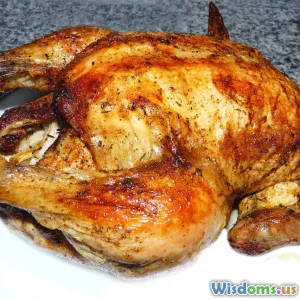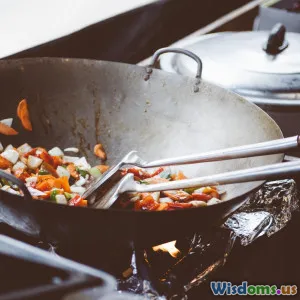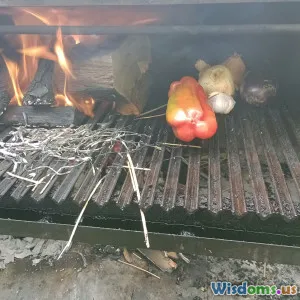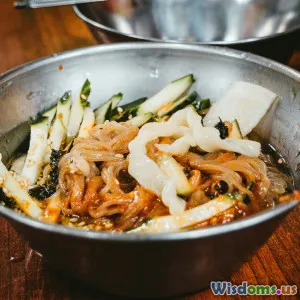
How to Batch Cook Chicken for a Week of Meals
14 min read Discover easy steps to batch cook chicken for delicious and diverse meals all week long. (0 Reviews)
Make Mealtime Effortless: How to Batch Cook Chicken for a Week of Meals
Busy schedules and tight routines often push healthy home-cooked meals to the bottom of our priorities. Yet, with a strategic approach called batch cooking, you can transform a basic staple—chicken—into a foundation for a week’s worth of flavorful and nutritious dishes. Not only does batch cooking save precious time, but it also helps curb unhealthy takeout habits, minimizes food waste, and keeps your budget intact. Here, we’ll reveal step-by-step how to batch cook chicken efficiently, safely, and creatively—so your meals stay exciting all week long.
Planning Your Chicken Batch Cooking Strategy

Success in batch cooking starts with preparation. Knowing how much chicken to buy, what cuts work best, and which additional ingredients you’ll need can make or break your week's convenience.
Deciding on Quantity and Cuts
First, consider your household size and typical serving portions:
- Adults: Plan for roughly 3–4 ounces of cooked chicken per meal.
- Kids: 2–3 ounces per serving. For a week’s worth of lunches and dinners for two adults, about 3 pounds of chicken suffices.
The chicken cut you choose influences flavor, texture, and recipe flexibility. Popular options:
- Boneless, skinless chicken breasts: Lean, mild, and versatile.
- Boneless, skinless chicken thighs: Juicier and more forgiving for reheating.
- Whole chicken: Economical and supplies meat for multiple uses—plus homemade stock from the carcass.
Building a Shopping List
List the core chicken cut(s) plus supporting ingredients for varied meals:
- Dried herbs and spices (paprika, oregano, garlic powder, cumin)
- Olive oil, lemon, garlic
- Your preferred marinades or sauces
- Serving essentials (grains, vegetables, salad greens)
Small investments in freezer-safe containers or glass meal prep boxes will smooth the process.
Preparing and Cooking Multiple Chicken Meals Safely

Handling raw poultry requires extra care, especially in a bulk cooking session. Streamlining your workflow without compromising food safety is key.
Batch Preparation
Set up an assembly line: designate a zone for unpacking, trimming, seasoning, and storing chicken to minimize risk of cross-contamination.
- Cleanliness counts: Sanitize counters, and use separate boards and knives for meat and produce.
- Even sizing: Trim chicken pieces for uniform thickness (helps in even cooking).
Marinating for Flavor and Juiciness
Marinate all or part of your chicken, using zip-top bags or shallow, covered containers. Try these ideas:
- Lemon-herb (olive oil, lemon juice, parsley, thyme, garlic)
- Southwest (lime juice, cumin, smoked paprika, chili powder)
- Asian-inspired (soy sauce, ginger, scallions, a dash of honey) No more than 24 hours in the fridge to keep texture optimal; never reuse marinades used on raw chicken unless boiled.
Cooking Techniques: Roasting, Grilling, and Poaching
Use methods that deliver maximum results with minimal effort:
- Sheet Pan Roasting: Place pieces on a large, rimmed baking sheet, roast at 400°F (200°C) for 22–28 minutes, flipping once.
- Grilling: Ideal for flavor and efficiency, particularly for thighs and bone-in parts.
- Poaching: For ultra-moist chicken, simmer breasts gently in water or broth with aromatics for 12–15 minutes.
Cook to an internal temperature of 165°F (74°C). Let chicken cool slightly before slicing (retains juices).
Breaking the Monotony: Seasoning and Portioning Chicken for Variety

Prevent "chicken fatigue" by pre-seasoning and portioning differently for each day’s meals.
Seasoning in Batches
Consider seasoning half your batch with Mediterranean flavors and the other half with an Asian or Latin American blend. For example:
- Herb-roasted: Parsley, rosemary, cracked pepper, garlic
- Spicy chipotle: Chipotle in adobo puree, cumin, and coriander
- Ginger-soy: Soy sauce, sesame oil, ginger, scallions This approach creates seemingly new dishes throughout the week, cutting monotony despite using the same protein base.
Dividing Into Portions
Once the chicken cools, dice, shred, or slice it based on the planned meals. Store each seasoning-type in a separate airtight container—label and date.
- Single-serving containers allow grab-and-go convenience for lunches.
- Larger containers are perfect for assembling family dinners on the fly.
Storing Batch Cooked Chicken for Maximum Safety and Taste

Getting the most from your batch-strategy hinges on correct chilling and storage:
- Cool rapidly: Place cooked chicken in shallow containers. Refrigerate within 1 hour of cooking (the USDA says 2 hours, but faster is safer).
- Label clearly: Note the date and type to minimize confusion.
- Fridge shelf-life: 3–4 days for cooked chicken; freeze what won’t be eaten by then (up to 3 months).
- Defrosting safely: Move frozen portions to the fridge a day before eating, or use the microwave’s defrost function in a pinch. If storing with sauces, keep these separate to preserve texture and prevent sogginess.
Five-Day Meal Plan: Creative, Nutritious Chicken Dishes

A batch of simply seasoned chicken opens the door to meal diversity. Here’s a vibrant five-day lineup to inspire your menu:
Day 1: Mediterranean Grain Bowls
Combine cubed herb-roasted chicken with cooked farro or quinoa, roasted vegetables, feta cheese, and a squeeze of lemon.
Day 2: Southwest Chicken Salad Wraps
Wrap lime-cumin chicken with black beans, grape tomatoes, corn, romaine, and avocado—drizzle with a yogurt-based chipotle sauce.
Day 3: Chicken and Veggie Stir-Fry
Dice ginger-soy chicken and toss in a hot pan with snap peas, carrots, and bell peppers. Serve over brown rice and top with toasted sesame seeds.
Day 4: Chicken Tortilla Soup
Simmer shredded chipotle chicken in chicken stock with tomatoes, corn, and cilantro. Top with crispy tortillas and a dollop of sour cream.
Day 5: Deconstructed Chicken Caesar
Layer poached chicken strips over crisp romaine, shaved Parmesan, whole-grain croutons, and homemade Caesar dressing for a lighter take on a classic.
Remember, these are just templates—mix and match veggies, grains, and toppings based on your taste and what you have on hand.
Tips for Batch Cooking Success and Efficiency

Batch cooking rewards planning and process. Here are insider tricks for speed and sustainability:
- Double up: While the oven’s on, roast a tray of vegetables beside your chicken for instant meal building blocks.
- Freeze flavor boosters: Portion chopped onions, garlic, or ginger in silicone trays for easy weeknight use.
- Invest in quality containers: Glass containers preserve freshness and are oven and microwave safe.
- Play with sauces: Store a few homemade sauces (vinaigrette, tzatziki, peanut sauce) in jars to instantly reinvent leftovers.
- Manual or electric shredders: For big batches, use these tools to quickly shred cooked chicken for salads and soups.
- Reuse or repurpose: Broth from poaching doubles as soup base, grains cook great in it too!
Troubleshooting Common Pitfalls in Chicken Batch Cooking

Even seasoned batch cookers can hit snags. Being proactive can keep your meals tasting fresh and delicious all week.
- Dry chicken: Overcooking, especially breasts, leads to dryness. Always check internal temperatures and don’t skip a resting period.
- Blandness: Feel free to be generous with spices and marinades—chicken can take on big flavors.
- Soggy texture: Store chicken separate from sauces or juicy vegetables, recombine when serving to protect texture.
- Reheating mistakes: Reheat gently, with a splash of water or broth and cover to trap steam. Microwaving on medium avoids turning perfectly cooked chicken rubbery.
- Spoilage: Label and rotate stock, and freeze anything you won’t eat in 3–4 days. If it smells or looks off, toss it.
Sustainable Batch Cooking: Reducing Food Waste

Batch cooking is inherently eco-friendly, as it limits single-use packaging, prevents random leftovers, and puts you in control of ingredient use. Push this further by:
- Planning meals strategically: Prep components that get reused—grilled chicken one night, sandwiches the next lunch, soup the next.
- Reimagining odds and ends: Turn scraps of chicken and veggies into frittatas, fried rice, or hearty salads.
- Composting: Coffee grounds and veggie peels? Compost instead of trashing, if possible in your community.
- Upcycling chicken bones: Simmer with celery, carrot, and onion for fortifying homemade stock—a flavorful base for your next batch.
Embracing Variety: Expanding Your Chicken Batch Repertoire

Once you're comfortable with simple batch cooked chicken, adventure calls. Explore world cuisines:
- Indonesian: Shred cooled chicken, stir with kecap manis, and serve over coconut rice.
- Moroccan: Combine diced chicken with harissa, chickpeas, and preserved lemon.
- French: Toss sliced chicken with Dijon, tarragon, and roasted potatoes.
- Indian: Simmer in tikka masala sauce for a quick stovetop curry. Every week can reveal a new taste territory—without radically changing your workflow or increasing prep time.
Preparedness brings peace of mind and palate. By mastering batch cooking, you seize mealtime control, maximize your grocery budget, and ensure home-cooked, nutritious meals are always within reach—even on life’s busiest days. The humble chicken, when prepped in advance and dressed up day-to-day, will never taste like last night’s leftovers.
Rate the Post
User Reviews
Popular Posts

















